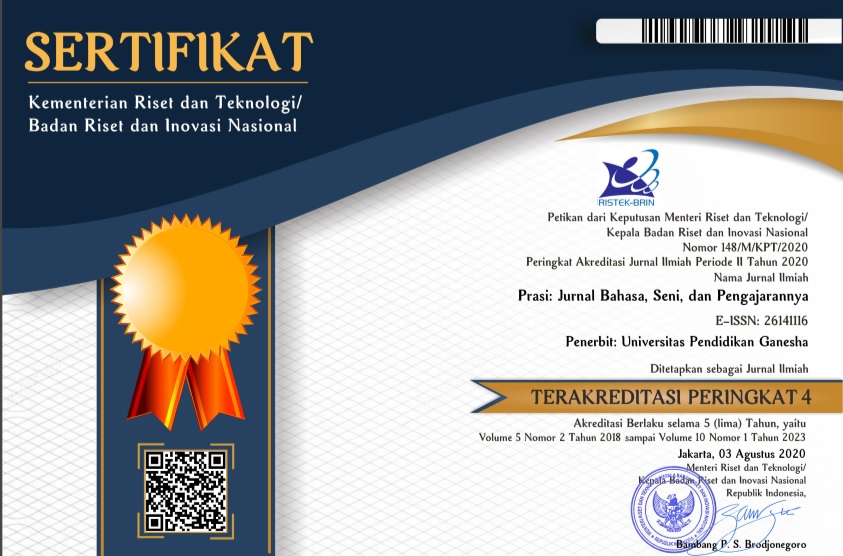PERILAKU VERBAL DAN NONVERBAL DALAM AKTIVITAS SENI MABEBASAN (KAJIAN SOSIOPRAGMATIK)
DOI:
https://doi.org/10.23887/prasi.v7i13.435Abstract
This research with its descriptive design aimed at (1) investigating as well as describing the types ofverbal and non-verbal behaviours used in the art of mabebasan activities, (2) finding out of describing the functionof each type of nonverbal behaviours, and (3) finding out the extent to which proportion of the appearanceof verbal and nonverbal behaviours in the art of mabebasan activities. The data about the function of nonverbal behaviours in mabebasan activities were collected through questionnaire and interviews. While conducting theinterview and observation, recording by using handycam and notetaking were also done. The collected datawere then analyzed, using quantitatively descriptive method and qualitatively method.
Based on the result of data analysis done, it can be concluded as follows. Firstly, not all linguisticmacro functions advocated by Searle arise in mabebasan activities. Gradually, the types and frequencies oftheir occurance are as follows (1) representative function appeared 166 times (66.40%), (2) directive functionappeared 41 times (16.40%), and (3) expressive function appeared 43 a times (17.20%). There were no commisiveand declarative functions found. Secondly, in general viewed from the types of actions, it was foundout that there five types of nonverbal behaviours, which can gradually be classified as follows: (1) hand movements1 (0.40%). These findings were in accordance with the result of the questionnaire, in which the interpreters(the translators from the source language to Balinese) stated that the movements mostly used in mabebasanwere hands movements.
Thirdly, in the activities of the art of mabebasan, the non-verbal behaviours or actions are very important,nonverbal behaviours like head movement, body movement, hand movement the combination of headand body movement, and the combination of head, body, and hand movement, always accompany the processof perfoming and interpreting in mabebasan. Without such movements, interpreting in mabebasan seems notto be serious or complete, the performance in mabebasan is not interesting or artistic; the appearance is not sopolite; the performance is not so complete; the mabebasan activities are so life/natural; language use becomesimperfect.
In relation to speech function, there are three types of nonverbal behaviours identified in mabebasannamely : (1) nonverbal behaviours functioning to complete, emphasize or clarify the representative functioningof speech, (2) nonverbal behaviours which function to complete, emphasize or clarify the directive function ofspeech, and (3) nonverbal behaviours having the role of completing, emphasizing, or clarifying the expressivefunction of speech.
Fourthly, quantitatively, it seems that there is a correlation between the frequency of the occurance ofverbal behaviours and nonverbal behaviours. It means that every speech/speech act is really accompanied byaction/movements. Verbally, it was found that there were 250 speeches, and nonverbally it was found out thatthere were 250 types of nonverbal behaviours in mabebasan activities.
Keywords: verbal behaviour, nonverbal behaviour, function of nonverbal behavior, speech act
Downloads
Published
Issue
Section
License
Authors who publish with Prasi agree to the following terms:- Authors retain copyright and grant the journal the right of first publication with the work simultaneously licensed under a Creative Commons Attribution License (CC BY-SA 4.0) that allows others to share the work with an acknowledgment of the work's authorship and initial publication in this journal
- Authors are able to enter into separate, additional contractual arrangements for the non-exclusive distribution of the journal's published version of the work (e.g., post it to an institutional repository or publish it in a book), with an acknowledgment of its initial publication in this journal.
- Authors are permitted and encouraged to post their work online (e.g., in institutional repositories or on their website) prior to and during the submission process, as it can lead to productive exchanges, as well as earlier and greater citation of published work. (See The Effect of Open Access)


.png)
.png)









